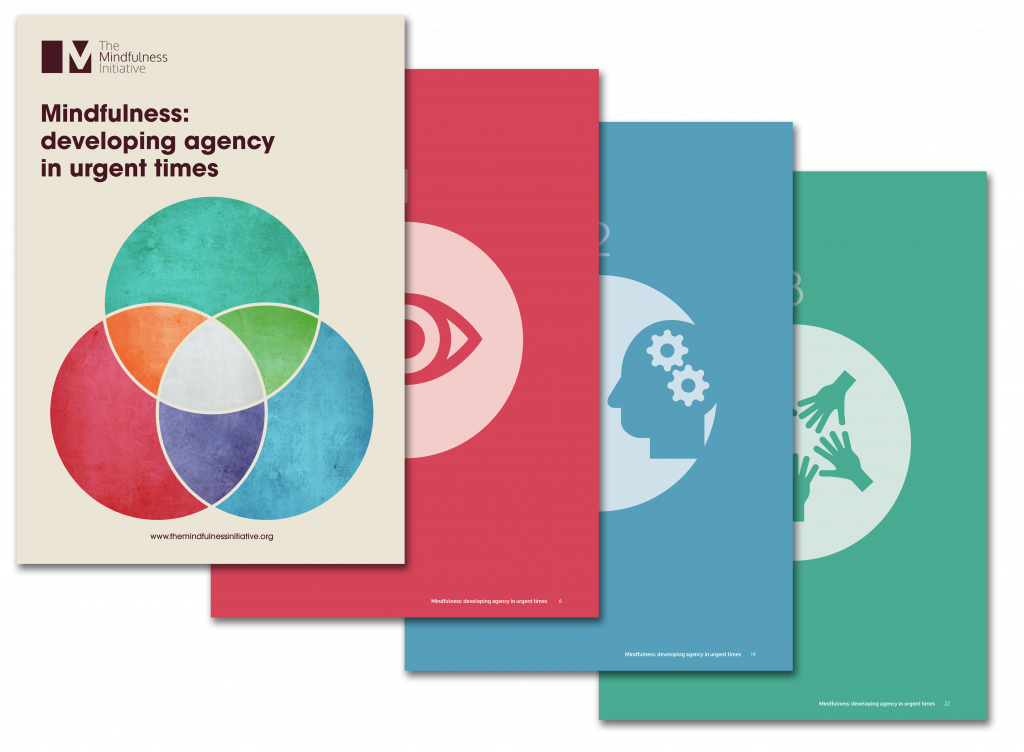By Chivonne Preston

This week, I attended the launch of the seminal discussion paper “Mindfulness: Developing Agency in Urgent Times” by the UK’s policy institute, the Mindfulness Initiative. For those of us worried that mindfulness is at risk of being erroneously perceived as promoting passivity and compliance, this paper expertly outlines the progression from individual mindfulness practice to conscious action, mutual collaboration and collective agency. For those of us worried that the pernicious human devastations of the 21st century are unstoppable, this paper gives us hope.
Read the paper in full yourself here. And once you’ve read the paper, use the superb further reading and listening list in the Appendix to identify your next podcast or article to curl up with. But I also wanted just to draw out a couple of themes that particularly resonate for mindfulness in schools:
Mindfulness is active
In my view, one of the reasons that mindfulness practice is so empowering for children and young people is that they choose to do it. Whilst a Paws b or .b teacher can explain why they might do it, and how they might do it, only the individual child can choose to shift their attention to their body or their breath (or their chocolate minstrel), in that moment. And we know that they frequently do choose to, and that this is often not just empowering but liberating: for them in that moment, but also to have this skill for the rest of their lives.
From the very beginning, mindfulness requires intention: it is a choice, and it is active (not passive)!
Mindfulness teaches you to control your attention
And as this paper explains, it is the intentional reclaiming of attention (particularly in this distracting world of evolving technologies with algorithms that ‘hijack’ our minds) that increases our receptivity to our experience of the world around us. We intentionally look up. We are open, and curious as to what is there, because we have intentionally shifted away from our autopilot which assumes it knows what it will find.
For children and young people, at real risk of looking down at their devices and being constantly diverted by content chosen and sensationalised by others, this skill is never more needed. The ability to intentionally pause and assess the first-hand evidence can not only strengthen their capability to assess what is real and what is not, but it can also protect them from, at best, timewasting, and at worst, harm. It can help them shift attention away from the constant broadcast of social media commentary, videos, celebrity news and other people’s opinions and instead place their attention, with care, elsewhere.
Mindfulness stimulates a conscious response
This ‘heightened capacity of perspective’ can enable us to connect with what is important, and choose our response to what is actually there. Rather than automatically reacting, we can consciously pick our response and be able to do so in the specific context we find ourselves in. Mindfulness gives us choice as actors with agency!
When children and young people, who are constructing their own identities and developing their own independence, grasp this concept it can be enlightening and inspiring. They can actively assess what is happening to them, and what they will do next, offering a kind of freedom which for many is entirely new.
Mindfulness promotes collaboration
Whilst the realisation of conscious response can build confidence, the practising of conscious response (as the paper explains) increases the ‘capacity for novelty’, and encourages openness and curiosity.
This promotes better collaboration between individuals as, perhaps unsurprisingly, we work better together when we are open to each other’s experiences and viewpoints. The paper’s authors refer to fascinating research which links mindfulness to reductions in discriminatory behaviour and resistance to bias.
And we know this from our experience of mindfulness in schools. We know that teaching mindfulness to children and young people supports them in their relationships, in resolving differences and in enjoying other people’s company. We also know that embedding mindfulness within the wider school culture, teaching mindfulness to everyone, enhances relationships throughout the school community and fosters a greater sense of shared purpose and mutual support.
Collaboration enables collective intelligence and collective agency
Sociologists have long recognised and researched the value of the group, and the advantages of moving from ‘me-based’ to ‘we-based’ in terms of survival and development. The paper’s authors propose that it is only by working collectively that we might resolve the very complex issues of the 21st century (such as the environment and the rise of artificial intelligence) which are just too big for an individual to process alone. Mindfulness provides skills and values that support this.
And I don’t disagree that mindfulness could help save the world! But scaling down slightly, there is equally, for me, a more modest objective.
Mindfulness can help each individual flourish
Teaching children and young people mindfulness prepares them to live an authentic, connected life. Giving them skills to collect and assess primary data about their own experiences, to choose their own response, to work collaboratively, to recognise and value other people’s difference within a team, to develop collective intelligence, can give them skills to flourish. To maintain a job. To build relationships. To problem solve with peers. To manage difficulties. To enjoy the chocolate minstrel! And to understand their role as prime agents in their own lives. They learn they have individual agency. They learn how to foster collective agency. This certainly brings hope for the future of our world.
Read the paper! The co-authors Jamie Bristow, Rosie Bell and Dan Nixon have done an excellent job reviewing the evidence and making their case, and have certainly made me reflect on the exciting opportunities that teaching mindfulness in schools brings.
Read more publications from the Mindfulness Initiative or visit their website to find out more about their work.